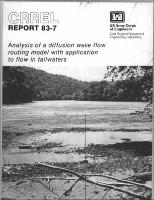Please use this identifier to cite or link to this item:
https://hdl.handle.net/11681/9313Full metadata record
| DC Field | Value | Language |
|---|---|---|
| dc.contributor | Tennessee Valley Authority. Water Systems Development Branch | - |
| dc.contributor | University of Michigan. Department of Civil Engineering | - |
| dc.contributor.author | Ferrick, M. G. | - |
| dc.contributor.author | Bilmes, J. | - |
| dc.contributor.author | Long, S. E. | - |
| dc.date.accessioned | 2016-06-20T13:41:14Z | - |
| dc.date.available | 2016-06-20T13:41:14Z | - |
| dc.date.issued | 1983-03 | - |
| dc.identifier.uri | http://hdl.handle.net/11681/9313 | - |
| dc.description | CRREL Report | - |
| dc.description | Abstract: Peak power generation with hydropower creates tailwater flow conditions characterized by high and low flows with abrupt transitions between these states. Flows occurring in tailwaters typically form sharp-fronted, large-amplitude waves of relatively short period. An understanding of the mechanics of downstream propagation of these waves is important both for direct application in studies of the tailwater and because of the similarity of these waves to those following a dam break. An analysis of the dynamic equations of open channel flow is used to quantify the relative importance of flow wave convection, diffusion and dispersion in rivers. The relative importance of each process is related to the relative magnitude of terms in the dynamic equations, providing a physical basis for model formulation. A one-dimensional diffusion wave flow routing model, modified for tailwaters, simulates the important physical processes affecting the flow and is straightforward to apply. The model is based upon a numerical solution of the kinematic wave equation. The "modified equation," Hirt, and von Neumann analyses are used to gain insight into the stability and dissipative and dispersive behavior of the numerical solution, and results of these analyses are compared. A set of linear routings is used to demonstrate the dissipative and dispersive behavior predicted by the analyses and to verify the accuracy of an expression that quantifies the numerical diffusion of the model. The analyses provide a basis for selection of numerical parameters for model applications. The capability and accuracy of the model are enhanced when physical wave diffusion is balanced by numerical diffusion in the model. Maintaining the diffusion balance requires that the time derivative weighting parameter θ be variable and in some instances negative. Though some amount of phase error is introduced, negative θ values have no adverse effect upon model stability. Field studies were conducted to demonstrate the benefits of careful model development and analysis, and to verify the diffusion wave model for rapidly varying tailwater flow. The bed slope and roughness characteristics of the field study reaches (below Apalachia and Norris Dams) differ greatly, spanning those of a large number of rivers of practical interest. The accurate simulation of flow in both of these tailwaters attests to the soundness of both the physical basis of the model and the numerical solution technique. The field studies confirm, for the extreme case of rapidly varying flow in a mildly sloped river, that inertia has a negligible effect upon unsteady flow waves at low Froude numbers. Additionally, these studies verify that diffusion of short-period waves in rivers is generally significant. | - |
| dc.publisher | Cold Regions Research and Engineering Laboratory (U.S.) | - |
| dc.publisher | Engineer Research and Development Center (U.S.) | - |
| dc.relation | http://acwc.sdp.sirsi.net/client/en_US/search/asset/1005852 | - |
| dc.relation.ispartofseries | CRREL report ; 83-7. | - |
| dc.rights | Approved for public release; distribution is unlimited. | - |
| dc.source | This Digital Resource was created from scans of the Print Resource | - |
| dc.subject | Dams | - |
| dc.subject | Flow routing | - |
| dc.subject | Hydrology | - |
| dc.subject | Hydraulics | - |
| dc.subject | Mathematical analysis | - |
| dc.subject | Numerical methods | - |
| dc.subject | Peak power | - |
| dc.subject | Rivers | - |
| dc.subject | Water flow | - |
| dc.subject | Waves | - |
| dc.subject | Water waves | - |
| dc.title | Analysis of a diffusion wave flow routing model with application to flow in tailwaters | - |
| dc.type | Report | en_US |
| Appears in Collections: | CRREL Report | |
Files in This Item:
| File | Description | Size | Format | |
|---|---|---|---|---|
| CR-83-7.pdf | 2.08 MB | Adobe PDF |  View/Open |